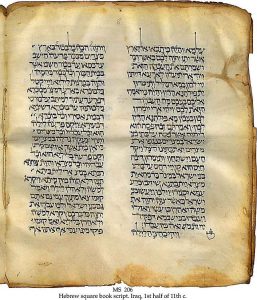The Targumim, Emanuel Tov, Textual Criticism of the Hebrew Bible, Fortress Press, Minneapolis 1992.
P.S. Alexander, “Jewish Aramaic Translations of Hebrew Scriptures,” in- Mulder, Mikra, 217–253; J. Gray, “The Massoretic Text of the Book of Job, the Targum and the Septuagint Version in the Light of the Qumran Targum (11QtargJob),” ZAW 86 (1974) 331–350; B. Grossfeld, The Targum Onqelos to Genesis-Deuteronomy (The Aramaic Bible, The Targums, vols. 6–9; Edinburgh 1982–1988); M.M. Kasher, Aramaic Versions of the Bible (Torah Shelemah 24; Heb.; Jerusalem 1974); Y. Komlosh, The Bible in the Light of the Aramaic Translations (Heb.; Tel Aviv 1973); E. Levine, The Aramaic Version of the Bible- Contents and Context (BZAW 174; 1988); M. McNamara, “Targums,” IDBSup, 856–861; R. Weiss, “Recensional Variations between the Aramaic Translation to Job from Qumran Cave 11 and the Massoretic Text,” Shnaton 1 (Heb. with Eng. summ.; Jerusalem 1975) 123–127; idem, The Aramaic Targum of Job (Heb. with Eng. summ.; Tel Aviv 1979).
The meaning of the word targum is explanation, commentary, and even translation, and later, specifically, translation into Aramaic.
Among the various biblical translations, the Jewish Targumim (as opposed to the Samaritan Targum [see p. 81]) had a special status in Judaism. The medieval commentators often quoted from them, and in the Rabbinic Bible (see p. 78) their texts were printed in full alongside the Hebrew text. Different Targumim were made of almost all the books of the Bible (excluding Ezra, Nehemiah, and Daniel).
Probably some of the Jewish Targumim were originally created orally and were committed to writing only at a later stage. From the outset it seems surprising that Aramaic translations were made at all, since this language is so close to Hebrew. During the Second Temple period, however, the knowledge of Hebrew began to decrease when it was replaced by Aramaic. Therefore, the people became more fluent in this language than in Hebrew.
Although tradition ascribes the first Targum to Ezra, it is not clear when the first Targumim were produced. In any event, the Targum fragments found in Qumran (4QtgLev [4Q156], 4QtgJob [4Q157], 11QtgJob)103 are early. Both free and literal Targumim were made, and it is generally assumed that the freer Targumim are earlier.
The Hebrew text reflected in all the Targumim is very close to M, except for the Job Targum from Qumran, which sometimes deviates from the other textual witnesses. Since the Qumran fragments are the earliest evidence of Targumim preserved, it is possible that the other Targumim also once deviated more from M, but were subsequently adapted towards its text.
Many of the Targumim have been published in critical editions.
a. Targumim to the Torah
a. Targum Onqelos
Targum Onqelos (TO) is the best known of the Targumim, and according to the Talmudic tradition (b. Meg. 3a) it was made by Onqelos the proselyte, “under the guidance of R. Eliezer and R. Joshua” (see also n. 98).
Scholars are divided in their opinions about the date (first, third, or fifth century CE) and origin (Babylon or Palestine) of TO. Nevertheless, even if its final literary form is late, it was possibly preceded by a written or oral formulation similar to the one contained in the fragments of Leviticus found in Qumran.
As a rule TO follows the plain sense of Scripture, but in the poetical sections it contains many exegetical elements. It almost invariably reflects M, although sometimes its Vorlage cannot be recognized easily behind the extensive layer of exegesis. Sperber noted some 650 variants of TO, all of which pertain to minor details.
ß. Palestinian Targumim
(1) Jerusalem Targum I = Targum Pseudo-Jonathan. From the fourteenth century on this translation has been incorrectly named Targum Jonathan (from the abbreviation ת”י = Targum Yerushalmi). This translation also integrates elements from TO.
(2) Jerusalem Targum II, III = The “Fragment(ary) Targum(im)” (=TF), so named because only fragments of it have been preserved in manuscripts and in printed editions (see plate 25*).
(3) Targumim from the Cairo Genizah (see p. 33 and Klein [n. 104]).
(4) Vatican Neophyti 1 (see plate 23*), discovered in 1956 in a manuscript dating from 1504 (=T N). According to its editor, the Targum contained in this manuscript originated in the first or second century CE, while others ascribe the translation to the Talmudic period (fourth or fifth century CE).
b. Targum to the Prophets
Targum Jonathan to the Prophets (see plate 22*) varies from book to book. The Babylonian tradition ascribes it to Jonathan ben ‘Uzziel, a pupil of Hillel the Elder.
c. Targum to the Hagiographa
According to the story in t. Shabb. 13.2; b. Shabb. 115b; y. Shabb. 16.15c, the Job Targum already existed at the time of Gamaliel the Elder (first half of the first century CE), and an early source of this Targum has indeed been found in Qumran. The Job Targum from Qumran contains a literal translation, sometimes reflecting a Vorlage different from M (see Weiss*, 1979, 27–30 and Gray*), and it possibly lacks the last verses of the book, 42-12–17. The printed version of the Job Targum differs from the Qumran text.
For Esther two different Targumim, Targum rishon, “first Targum,” and Targum sheni, “second Targum,” are known, both which are midrashic in nature.
Pages 148-151
What do you want to know?
Ask our AI widget and get answers from this website
